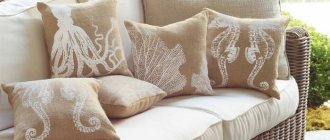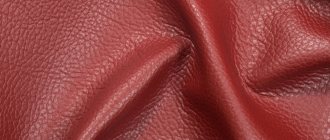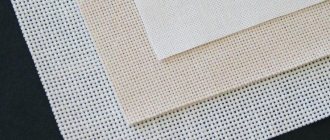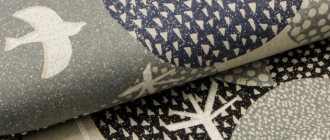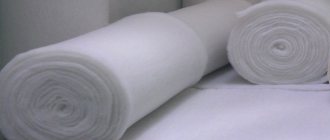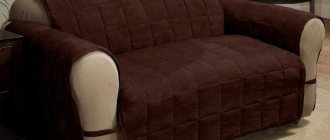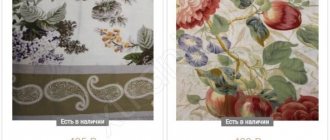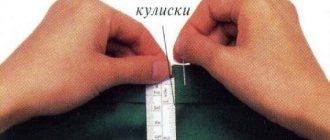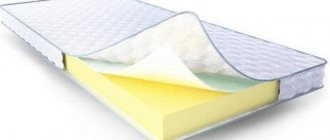Types of materials
Various everyday items are created from textiles: towels, curtains, covers, bedding. Fabrics are used in both manufacturing and home crafts. The following types of textiles are distinguished:
- natural;
- mineral;
- artificial.
The first type of fabric is made from animals and plants: wool, fur, silk, cotton, linen. Plant materials are considered the most valuable. Their unique properties make it possible to wear clothes during warm periods. Natural textiles are loved by connoisseurs of environmentally friendly fabrics. Clothes made from them are easy to wash, but wrinkle quickly.
Mineral textiles are in demand for creating work clothes. It contains glass, basalt, asbestos. Thanks to these components, products acquire the necessary properties. Glass is used in the creation of ropes, nets, and cables. The use of mineral material in the manufacture of precious stones is popular.
Clothing is made from synthetic textiles. The most popular materials include nylon, polyester, acrylic, lurex, lycra. Their advantage is affordability compared to other fabrics. They are great for people with allergies because they do not cause irritation.
Meaning of the word textile
Examples of the use of the word textile in literature.
Sassoon, Tata, Birla, Redimani, Jeejeebhoy, Kama, Vadya, Bhaba, Gokuldas, Vacha, Cashondelivery - these powerful companies had a stranglehold on the city, controlling precious and industrial metals, chemicals, textiles and spices, and they were not going to give up their positions.
The space opening up ahead was carefully expanded or replenished by those who were offered to the compiler as connecting links: the Royal Geographical Society in London, the National Library of Serbia in Belgrade, the Uffizi Gallery in Florence, the Textile Museum in Washington, the Chinese Collection of the Oriental Institute in Chicago, the Tretyakov Gallery in Moscow, the State Archive in Venice, the Hall of Freshness of the El Escorial Palace, the Metropolitan Museum of Art in New York, the Gazi-Husrevbek Library in Sarajevo, the Gallery of Mirrors in Geneva, the Royal Museum of Fine Arts in Brussels, the Astronomical Observatory in Belgrade, the Topkapi Museum in Istanbul, Glass Museum in Murano, Yugoslav Film Library in Belgrade, Institute of Witchcraft in Lagos, Prado in Madrid, Botanical Department of the Academy of the Invisible in Leningrad, Travel Museum in Delhi, Commissariat of Parks, Grass and Monuments in Grad, Cabinet of Maps and Globes of the National Library of Serbia in Belgrade, National Legate of Dreams in Paris, Toy Museum in Michelstadt, National Portrait Hall
But it is not the Barnaul pimokat that decides the matter, but the Moscow, Leningrad metal worker, Ivanovo textile, Donetsk miner.
The factory committee acted not entirely democratically when electing delegates to the emergency textile congress.
The Japanese's mastery of textiles, petrochemicals, electronic products, televisions, tape recorders, cameras, and their use of modern management and marketing techniques turned Japan into a great industrial power.
The Japanese leaders did not miss their chance and, continuing to maintain a subordinate, even humiliated position in relation to the Americans, gradually overtook America: first in the production of textiles, steel, ships, cars and petrochemical products, and then in electrical and electronic goods and, finally, computers .
The fact that the textile link concerns the production of items for all personal consumption of the peasantry, affecting relatively little the production side of the peasant economy.
Having started with the development of labor-intensive industries based on the use of cheap labor: agriculture, textiles, clothing, sports shoes, Taiwan continued to move forward persistently.
But I won’t return to textiles again - I can’t see these desks with supervisors anymore.
To begin with, I again surrendered to textiles - to one seedy place owned by former hippie Michael Popov.
I again gave myself up to textiles, took a job from an old Armenian woman, didn’t put much effort, but still earned something.
And you could go to the old Armenian woman, take textiles and draw at home without straining yourself.
And, as usual, a couple of days later - according to a specially thought out and drawn up together with Irka, the Seduction Plan, I called Kolya again and in an innocent voice said that I wanted to leave textiles and try my hand at illustration, in a word, could I come up and show him your graphic portfolio.
We managed to attract investors from Hong Kong and Taiwan, who built factories for the production of toys, textiles, and ready-made clothing.
I added that we could somehow understand that we had problems with the import of textiles and umbrellas, but the problems with the import of calculators and orchids came as a complete surprise to us.
Source: Maxim Moshkov library
Textile production
The first fabrics began to be created in ancient times. At first, people wore clothes made of cotton, linen and wool. Weaving came about through weaving. Modern production technologies and machines make it possible to produce a large number of different types of canvas. Fabrics can be either household or industrial. If we classify them according to their purpose, they are divided into linen, dress, and costume. If the fabrics contain fibers of the same type, then they are considered homogeneous.
For children, textiles, knitwear, calico, chintz, and madapolam are usually chosen. The materials do not cause allergies and are therefore excellent for creating comfortable clothing. Cotton fabrics, including linen, satin, and flannel, are very popular.
By composition
The main criterion for classifying fabrics is the origin of the fibers. There are several groups, each of which has specific characteristics.
Natural
The raw materials for textile production are fibers created by nature. Such fabrics are especially highly valued because they have many advantages. Depending on the origin of the fibers, textiles of plant, animal and mineral origin are distinguished.
Linen
The fabrics are characterized by high hygroscopicity, thermal conductivity, strength, and abrasion resistance. They are produced in different densities: thin fabrics are used for tailoring, coarser ones are used for bed linen, furniture upholstery, and technical products.
The group includes: shirt and dress fabric, cambric, trim, tarpaulin, fine linen, burlap.
Cotton
The fabrics are “breathable”: they allow air to pass through perfectly, which contributes to proper heat transfer. They are distinguished by their hygroscopicity, softness, wear resistance, and low cost. But the main thing is that cotton textiles are safe for health. Therefore, it is used for sewing diapers, vests, clothes for pregnant women, and medical products. It is also in demand in the manufacture of clothing, home textiles, upholstery materials, and technical materials.
Materials: velvet, cambric, calico, corduroy, denim, diagonal, jacquard, satin, chintz, poplin, etc.
Fact! Cotton combines well with different types of fibers, so it is often present in mixed materials.
Silk
A special type of fiber obtained from silkworm cocoons, which are formed by caterpillar secretions. Biological fluid consists of proteins, fats, waxes, and minerals. The fabrics allow air to pass through well, absorb moisture, and drape well. They are light in weight and exhibit slight shrinkage.
Varieties: crepe de chine, cloque, silk, chiffon, satin, dupont, crepe, foulard.
Woolen
Raw materials are obtained from the wool of sheep, goats, camels, llamas, alpacas, and rabbits. The fabrics retain heat well, allow air to pass through, are resistant to stains, and wrinkle little.
Produced in varying degrees of density. Surfaces can be smooth or piled (on one or both sides). Like cotton, wool combines well with other types of fibers and is part of many mixed materials.
Examples: angora, flannel, boucle, gabardine, diagonal, drape, cashmere, loden, cloth, tweed, felt, flannel, cheviot.
Mineral
A special group of natural fabrics made from fibrous natural substances: asbestos, basalt, silica, awn. The materials are used for technical and production purposes: for heat and waterproofing, sewing fire-resistant clothing (for firefighters, rescuers, workers in oil and gas production, metallurgical plants, etc.).
Unnatural
Textiles are produced by weaving, knitting or gluing from fibers that do not exist in nature.
Artificial
The materials are made from fibers that are produced from natural polymers (proteins, cellulose) using special technologies. The raw materials are wood (most often spruce), rubber, glass and even goat milk. Depending on this, textiles are distinguished: viscose, acetate, triacetate, casein, etc. In appearance, they are almost identical to natural fabrics.
Types of artificial materials: acrylic, acetate, bamboo, viscose, nylon, lyocell, modal, nylon.
Synthetic
Fibers are obtained from substances that do not originally exist in nature, but are invented and synthesized from different types of monomers. The raw materials for them are derivatives of petroleum products, coal, and natural gas. The fabrics are characterized by increased strength, wear resistance, and elasticity. Resistant to microorganisms. Disadvantages include electrification, low breathability, and vulnerability to high temperatures.
Thanks to the rapid development of the chemical industry, such textiles today are represented by a huge range. The most common ones: alova, acrylan, supplex, membrane, microfiber, lycra, neoprene, polyester, polysatin, polyester, spandex, tulle, elastane.
Materials can consist of 100% synthetic fibers, but more often they are used in combination with natural threads.
Mixed
The most extensive group of fabrics that have a mixed fiber composition. Most often, natural and synthetic threads are combined. Natural fibers provide breathability, hygroscopicity, and comfort, while chemical fibers provide wrinkle resistance, low shrinkage, strength, and wear resistance. Plus - cheaper cost, ease of maintenance.
Blended textiles are made in two ways:
- From mixed fibers: threads of different origins are joined together at the spinning stage. Thanks to this, the yarn is uniform on all sides.
- Weaving dissimilar fibers on a loom. The threads can run along both sides of the fabric or only on one (for example, in a heated fabric, the front side is made of synthetic, the back side is made of cotton).
This group includes: guipure, tapestry, dior, double-thread, lace, twill, oil knitwear, flock.
Other types
In addition to flax and cotton, other plant fibers are also used in textile production:
- kenaf: grown in China, India, Asian countries. It is durable and hygroscopic. Used for the production of tarpaulin, burlap, twine, ropes;
- hemp: one of the most ancient crops used to produce canvas, linen, ropes, ropes;
- jute: grown in Asian countries, used in the production of furniture and technical materials.
Knitwear
Textiles, the fabrics of which can be of different types, are convenient for sewing any clothes. One of the practical materials is knitwear. It is created from the interweaving of loops, and the result is a high-quality fabric.
Many consider knitwear and other textiles to be the most comfortable materials, and this combination is excellent for making comfortable clothes. Knitwear is ideal for sewing items for work and leisure. It is indispensable in creating hats, toys, and household items. Knitwear differs from other materials in that it can stretch in different directions. It is elastic, soft, hygroscopic.
Twisted materials
Textiles, which come in a variety of fabrics, include spun materials. They can be silk, linen, wool. They are created in the likeness of fiber. Threads used to create fabrics can be bleached, starched, and dyed. That is why a variety of clothes are sold.
Threads come in different types, differing in thickness and colors. Specific needles are used for each. After the threads are created, different things are made in factories. The result is cozy, high-quality clothing.
What are home textiles?
Textile is fabric. But only a certain category of items fits the concept of home textiles. Moreover, it is far from important what materials home textiles are made from - since the concept is too broad and objects can have a variety of functions.
But at the same time, home textiles are entrusted with the most important function of interior items - to make the house truly cozy and comfortable.
It is difficult to imagine the life of an ordinary person without home textiles, since this concept includes many items used in everyday life.
Wicker materials
Not everyone knows that woven materials are included in the textiles section, and that such fabric is used in the creation of clothing. These include braided braid and soutache. Each type of material has its own pros and cons.
In woven braid, the threads are intertwined at a certain angle. Thanks to this, the finished fabric stretches easily and can be used in various projects. The braid can be silk, cotton, wool or mixed.
Not many people know that soutache is included in textiles, and that such fabric is used to make beautiful and high-quality clothing. It is presented in the form of a silk cord, which is actively used for finishing things and creating original products.
Window textiles
The materials are used not only for sewing clothes, but also for making household items. Any room will look more original if there are beautiful curtains hanging on the windows. Moreover, these can be not only classic curtains, but also draperies and lambrequins. All of these materials are created from textiles.
For different styles, certain colors, patterns and textures of curtains are used. This is what emphasizes the taste of the owners. Linen is perfect for creating a classic style. If ethnic design is required, then organza and brocade are suitable. And silk is suitable for high-tech. Textile materials create real home comfort.
Textiles are used to create bed linen, towels, bedspreads and many other things. The materials are of excellent quality, convenience, and originality. Textile clothing will be a wonderful gift for those who appreciate comfort.
